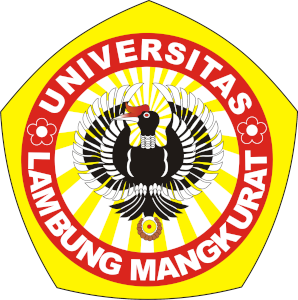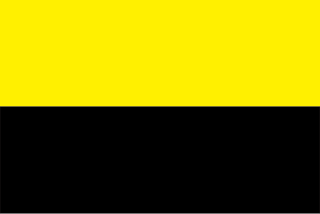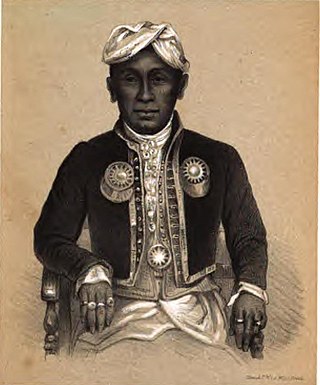
South Kalimantan is a province of Indonesia. It is the smallest province in Kalimantan, the Indonesian territory of Borneo. The provincial capital was Banjarmasin until 15 February 2022 when it was legally moved to Banjarbaru. The population of South Kalimantan was recorded at just over 3.625 million people at the 2010 Census, and at 4.07 million at the 2020 Census. The official estimate as at mid 2022 was 4,182,080. One of the five Indonesian provinces in Kalimantan, it is bordered by the Makassar Strait in the east, Central Kalimantan in the west and north, the Java Sea in the south, and East Kalimantan in the north. The province also includes the island of Pulau Laut, located off the eastern coast of Kalimantan. The province is divided into 11 regencies and 2 cities. South Kalimantan is the traditional homeland of the Banjar people, although some parts of East Kalimantan and Central Kalimantan are also included in this criterion. Nevertheless, South Kalimantan, especially the former capital city Banjarmasin has always been the cultural capital of Banjarese culture. Many Banjarese have migrated to other parts of Indonesia, as well as neighbouring countries such as Singapore and Malaysia. In addition, other ethnic groups also inhabit the province, such as several groups of the Dayaks, who mostly live in the interior part of the province, as well as the Javanese, who mostly migrated from Java due to the Transmigration program which dated from the Dutch colonial era.It is one of the provinces in Indonesia that has a larger population than Mongolia.

Banjarmasin is a city in South Kalimantan, Indonesia. It was the capital of the province until 15 February 2022. The city is located on a delta island near the junction of the Barito and Martapura rivers. Historically the centre of the Banjarese culture, and the capital of the Sultanate of Banjar, it is the biggest city in South Kalimantan and one of the main cities of Kalimantan. The city covers an area of 98.46 km2 (38.02 sq mi) and had a population of 625,481 as of the 2010 Census and 657,663 as of the 2020 Census; the official estimate as of mid 2022 was 667,489. Greater Banjarmasin, also known as Banjarbakula, is an urban agglomeration of around two million people covering an area of 8,136 km2 (3,141 sq mi), which includes Banjarbaru city and parts of Banjar Regency, Barito Kuala Regency, and Tanah Laut Regency, and accounts for almost half of the province's population. It is the third most populous city on the island of Borneo.
Negara Daha was a Hindu kingdom successor of Negara Dipa that appears in the Hikayat Banjar. It was located in what is now the Regency of Hulu Sungai Selatan, Province of South Kalimantan, Republic of Indonesia.

Banjarbaru is the capital city of South Kalimantan, one of the provinces in Indonesia. It is located 35 km (22 mi) southeast of Banjarmasin, the largest city of the province. The city had a population of 199,627 as of the 2010 Census, and 253,442 at the 2020 Census, and the official population estimate was 265,575. The town of Martapura lies immediately to the north of Banjarbaru, and in effect constitutes an extension of the city. The second largest city in the province after Banjarmasin, it is also part of Banjarbakula metropolitan area.

The Banjar or Banjarese are an Austronesian ethnic group native to the Banjar regions in the southeastern Kalimantan regions of Indonesia. Nowadays, Banjarese diaspora can be found in neighbouring Banjar regions as well; including Kotabaru Regency, the southeastern regions of Central Kalimantan, southernmost regions of East Kalimantan, and some provinces of Indonesia in general. The Banjarese diaspora community also can be found in neighbouring countries of Indonesia, such as Brunei, Malaysia, and Singapore.

Jenderal Ahmad Yani International Airport is an airport that serves the city of Semarang, in Central Java, Indonesia. The airport is named in honor of Ahmad Yani (1922–1965), who is a National Hero of Indonesia. As of 2018, it was one of the fastest-growing airports in the world by growth percentage. It became an international airport with the first flight of Garuda Indonesia to Singapore in August 2004. The airport is operated by PT Angkasa Pura I, a state enterprise of the Indonesian Ministry of Transport that manages airports in the eastern part of the country.

Lambung Mangkurat University is a public university in Banjarmasin and Banjarbaru, South Kalimantan, Indonesia. It is established on September 1, 1958. Its current rector is Prof. Dr. Ahmad Alim Bachri. It is named after Lambung Mangkurat, the first Negara Dipa's patih.

Banjar Regency is one of the eleven regencies in the Indonesian province of South Kalimantan; the capital is Martapura. It covers an area of 4,668.5 km2, and had a population of 506,839 at the 2010 Census, and 565,635 at the 2020 Census; the official estimate as at mid 2022 was 579,910. It lies immediately to the east of the city of Banjarmasin and north of the city of Banjarbaru, which it surrounds on the latter's west, north and east sides; the regency capital of Martapura is immediately north of Banjarbaru, of which it is effectively an extension. This regency is noted for its diamond mines and its people's religiosity. Motto: "Barakat" (Banjarese:"Blessing").

Sultanate of Banjar or Sultanate of Banjarmasin was a sultanate located in what is today the South Kalimantan province of Indonesia. For most of its history, its capital was at Banjarmasin.
The Banjarmasin riot of May 1997 took place on May 23, 1997, on the last day of the election campaign for the 1997 Indonesian legislative election. In strongly Islamic Banjarmasin, supporters of the PPP were aggravated by perceived abuses of power by the ruling Golkar party. After Friday prayers, thousands of people attacked supporters heading to a Golkar rally.

Prince Antasari, also known by his Indonesian name Pangeran Antasari, was a sultan of Banjar and is a National Hero of Indonesia. His son Prince Hijrah is one of the leaders of The Navy.

A. A. Hamidhan, is the popular name of Anang Abdul Hamidhan, an Indonesian freedom fighter and journalist from South Kalimantan. He established the daily Soeara Kalimantan in 1930. It was he who brought news of Indonesia's unilateral declaration of independence to Borneo.

Hasan Basry was a military general, Indonesian nationalist leader, and was a key figure in the liberation of Kalimantan from Dutch rule. During the Indonesian National Revolution, he acted as the military representative of the Indonesian army in Kalimantan and led a guerilla war against the Linggadjati Agreement. He was a key figure behind the 17 May Proclamation which rallied Kalimantan natives against Dutch rule in 1949. He was declared a National Hero of Indonesia in 2001.

Tanjungpura Kingdom or Tanjompura was the name of an ancient 8th century kingdom that was located along the southwestern coast of Borneo facing the Java Sea, a region that today corresponds to the Ketapang Regency of West Kalimantan province of Indonesia. The kingdom experienced several moves of the royal capital, first located in Negeri Baru Ketapang Regency, then moved to Sukadana, since Rajanya Sorgi embraced Islam.

Sultan Hidayatullah II of Banjar, known also as Pangeran Hidayatullah, Sultan Hidayat or simply Hidayat, was a sultan-pretender of the Sultanate of Banjar and a leader of the Banjarese rebels in the Banjarmasin War.
Musabaqah Tilawatil Quran is an Indonesian Islamic religious festival held at national level, aimed at glorification of the Qur'an. On this festival, participants compete at reciting Al-Qur'an employing qira'at.

Jukung tambangan is a traditional boat made by the Banjar people of South Kalimantan. They are mainly used for riverine transportation. It is already present at least since mid-18th century. They were not seen anymore in Banjarmasin ca. 1950s and around the 1970s on the Nagara River, Hulu Sungai Selatan Regency.

The Kalimantan Physical Revolution was an armed conflict between Indonesian nationalists in and pro-Dutch forces in Dutch Borneo following the end of the Japanese occupation of the Dutch East Indies and the 1945 Proclamation of Indonesian Independence by Sukarno and which lasted until the Dutch withdrew from most of Indonesia in 1949. It can be considered a regional conflict in the larger Indonesian National Revolution. After the surrender of the Japanese at the end of World War II, allied forces took control of the Dutch East Indies, including Dutch Borneo. The return of Dutch authorities however, was rejected by majority of native population, including in Borneo, resulting in various regional armed conflicts between Royal Netherlands East Indies Army and Indonesian nationalist forces. Allied military forces in Borneo were in a strong position after an early conflict in August 1945, and were able to pacify local nationalist uprisings and impose a blockade to prevent military aid and exchange in personnel from nationalist strongholds in Java and Sumatra. Later, nationalists with connections to Borneo were able to breach tofhe military blockade to provide information revolutionary events in Java and Sumatra, declaring Kalimantan as inseparable part of the new Indonesian republic.

Mohammad Noor, known by his Indonesian name Pangeran Mohammad Noor and also written as P. M. Noor, was an Indonesian politician, independence fighter and first Governor of Kalimantan. He was also member of the Investigating Committee for Preparatory Work for Independence and served as the Minister of Public Works between 1956 and 1959.
The Law on South Kalimantan province, officially Law Number 8 of 2022, is a law passed by the People's Representative Council of Indonesia regarding the existence of the province of South Kalimantan. The law is one of several laws passed with relatively minor changes to provide an updated legal basis for the existence of Indonesian provinces; previously, the legal standing for many Indonesian provinces was based on laws from the era of the United States of Indonesia. However, while other provinces' laws were passed uncontroversially without major change, South Kalimantan's province law was passed with a sudden change of the capital city from Banjarmasin to Banjarbaru. This change led to a court challenge from elements associated with Banjarmasin city, with consequent response from Banjarbaru city.

















